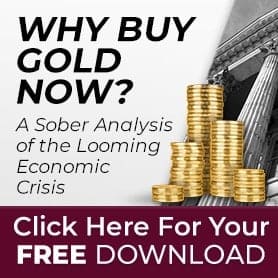- The Mario Draghi “No-Limits”-inspired rally from Thursday and Friday of last week ended on Monday with the Dow Jones down just over 200 points; the NASDAQ was down about 75 points, so an even bigger percentage drop
- But today the market reversed; the Dow actually recouped 100% of what it lost, it rose 282 points by the close
- A lot of volatility in the oil markets; down yesterday and up above $30/barrel today
- The bigger action today was in gold, up another $12 or so, the highest price for gold since the first week in November, last year
- Gold stocks had a big up day today, but they still have to rise about 8% to get back to where they were when gold was the price it is today
- Some of the battered down currencies in the commodities space had a good rally; the Canadian dollar and the Aussie dollar
- I think what the markets are preparing for is some type of statement from the Fed tomorrow; they began their 2-day meeting today and they will release a statement – there’s no press conference
- People are looking for the Federal Reserve to acknowledge some type of change in the economy and therefore soften their stance on their 2016 rate increase projection
- The last time we heard from Janet Yellen, the Fed was on track for 4 rate hikes in 2016, and since then, no one has said anything to contradict that, despite what has happened in the U.S. and global markets
- Perhaps this recent market rally will give Janet Yellen a reason not to show her hand
- Of course, if she disappoints the markets and continues to pretend everything is great, this market’s going down hard and all the gains will be surrendered
- Maybe she’ll try to walk a middle ground by acknowledging the problems in China and in the oil market and say that the Fed is monitoring the situation in case there us unexpected spillover to the U.S. economy which is still otherwise in great shape
- She may save face by suggesting that if these outside influences somehow wash up on our shores, and they effect employment and inflation, maybe it will adjust its policy
- I’m not sure if that will be enough for the market; if the market sells off, the Fed is going to have to come back and quickly release more dovish rhetoric
- I read an article on Monday’s Wall Street Journal and I posted it on my Facebook pageand it really was the equivalent of, This Time It’s Different
- The headline was, “Recession Signals are Flashing Red” – they’ve been flashing red for a long time and the WSJ has been ignoring it
- The article says that, despite all the bad economic events and data that in the past have led to recession, that this time it’s different
- The article tells us why we don’t have to worry this time, while acknowledging the bad data and events, they say we can rest easy because we have this really strong labor market, and in prior recessions the labor market wasn’t as strong
- Therefore, since the labor is so strong, we can ignore all the other signals that seem to be flashing recession
- I have said many times on this podcast, there is no strong labor market; it exists only in the eyes of statisticians who simply look at a rate of 5% and ignore how we got there
- They want to ignore the millions of people who have left the weak labor market and millions more who have settled for part time jobs
- So the weak labor market is consistent with all the other data that the WSJ is acknowledging, but tells us to ignore
- If we counted all the people outside of the labor market who are discouraged as unemployed, and we also counted all the underemployed people, and the unemployment rate was over 10%, then the WSJ would have to say, “Well, it’s a recession!”
- How can a recession wait for the government to decide how it wants to measure the labor market?
- It is what it is, regardless how the government wants to spin it
- If we honestly assess the situation, the conclusion is that the labor market is weak
- Since all the data is weak, and it is not something to ignore, we are either in a recession or rapidly heading to one
- The interesting thing about this WSJ article is that, in the comments, no one is buying what the WSJ is selling!
- Everybody knows the “This time it’s different” claim is the hallmark of every great bust, but somehow those who claim it never seem to realize it
- It’s always different this time: it was different during the dot com bubble, it was different during the housing bubble and the problem is they always believe it
- These statics can be spun anyway you want, if fact I want to talk about the Consumer Confidence number that came out today
- Consumer Confidence for January came out better than expected – last month the Consumer Confidence Index was 96.5
- For January, despite all the bad news this month so far, Consumer Confidence went up to 98.1
- How is that possible? Why are consumers so much more confident in January than in December?
- 98.1 is a pretty high read – What could it mean?
- Is it that most Americans don’t care what is happening in the stock market – but the actual reason is much deeper
- Look at the questions in the survey. The reason the number is higher this month than last month is that Consumers were more confident about two things:
- One, they were more confident that inflation would be higher in January than in December
- Two, they were more confident that interest rates would rise
- So consumers’ belief that prices and interest rates would rise is considered an expression of confidence in the economy
- To me, it reflects the opposite
- Economists equate higher interest rates with a strong economy
- They have the same conclusion with inflation – if consumers think prices will rise, that means they think the economy will improve
- Higher prices and interest rates are bad for the typical consumer
- To me, that signals less confidence in the economy
- These numbers don’t mean anything, because the surveys are set up to claim something that does not really exist
- One number that came out yesterday that was really bad was the Dallas Fed
- Dallas is right in the middle of oil country, so clearly very much affected by low oil prices
- The Dallas Fed Manufacturing Index was expected to be -14, which is a bad number
- They were expecting an improvement from December, which was -20.1
- They did revise the number for December to -21.6, but instead of improving in January to -14, the index crashed to -34.6
- You have to go back to the depth of the 2008-2009 financial crisis, with Lehman Brothers going bankrupt and the Dow dropping 1,000 points to find numbers this bad for the Dallas Fed Manufacturing Index
- Again, no one thinks we are going into a recession
- The service sector is still showing growth, but that growth is rapidly diminishing
- For example, the PMI Services Index came out for January at 53.7, down from 54.3 in December – the lowest in 13 months
- Still positive, but going in the wrong direction
- Same thing with the Richmond Fed Manufacturing – obviously not as heavily influenced by energy but still going down, last month it was 6, now it’s down to 2 for January, barely positive, how much longer will it be before the Richmond number turns negative as well
- We continue to get negative economic data and the data that wasn’t quite so negative is still getting worse – everything is going in the wrong direction
- The wealth effect is working in reverse
- The market will go lower if the Fed does not come to its rescue
- Even bigger is what can happen to the housing market – clearly the housing market is going down
- The bursting of the 2001 housing bubble created the real estate bubble
- Real estate prices started inflating before the stock market bubble popped, but when the stock market bubble popped, all that speculation with cheap money immediately went into fueling the real estate bubble
- This time, I don’t think we will have a real estate bubble; there are too many Americans out of the real estate market, this is a hedge fund/private equity market
- I think both bubbles will be bursting simultaneously, and now they are bigger, and the Federal Reserve doesn’t have the fuel to blow them back up again
- Rates were at 5.25 when the bubbles burst in 2008 and the Fed had a long way to move all the way to zero
- And then they had never done Quantitative Easing, and they did 1,2 & 3
- They don’t have all of that unused ammunition this time
- What are they going to do?
- They can try to take rates negative – they admit they are studying it – and they can restart QE
- There was an article in Bloomberg that was trying to assess the current probability of five scenarios for the Fed
- Only one of the scenarios involved recession; the other scenarios involved different paces of rate hikes
- Clearly, in the case of recession, the Fed will not just pause
- Based on Janet Yellen’s press conference following the September non-rate-hike, Yellen commented that if they raise rates and then a recession occurs, they will cut rates again
- You don’t get a lot of bang for that buck – how much stimulus do you get going from .25 to zero?
- It’s like trying to commit suicide by jumping from the basement window – you’re not going anywhere
- All they can do is to go negative and to go for QE, which will have to be huge in order to have an impact – talk about pushing on a string!
- The main thing for the Fed is to hold out, maintaining some kind of credibility
- As an investor, what I am more interested in is not when the Fed admits there is a problem, but when is the market going to figure out that the Fed is going to admit it
- It’s not a question of, will they reverse course, but how soon, and how big will the next round of stimulus be?
- Even if the Fed doesn’t want to admit it, everybody else should figure it out
- Again, the important point is not that they were mistaken, when they raised rates, that they raised rates too soon
- The mistake was believing they could raise rates without precipitating a financial crisis
- The mistake was lowering interest rates in the first place – that sealed our fate
- Whenever they raised interest rates all hell would break loose
- That’s what I always said the Fed was trying the impossible
- The only thing propping up the markets was the Fed
- Now it is obvious, as everything is falling apart, and the rest of the world can figure it out on their own
- Also I posted a new commentary on this website, “Clueless in Davos” and I suggest you give it a read
- One of the things I thought about, regarding why the other central bankers don’t advise Janet Yellen to consider more stimulus
- The Europeans and the Japanese are both active stimulating, even as their economies are improving
- The U.S. economy is decelerating, yet we are tightening
- The motivation could be that the U.S. must be the example of how Quantitative Easing can succeed, so they want Yellen to demonstrate, or at least pretend that it works, therefore the other central bankers have cover to follow suit
- If the Fed has to go back to zero and do more QE, it would be an admission that the policy failed, and that our monetary policy did not work
- Eventually the Fed is not going to be able to keep up the pretense, the U.S. recovery is going to be exposed for the sham that it is, we’re going back to stimulus and it will be a big wake-up call for the rest of the world to abandon those policies so they don’t go down with our sinking ship
Podcast: Download










